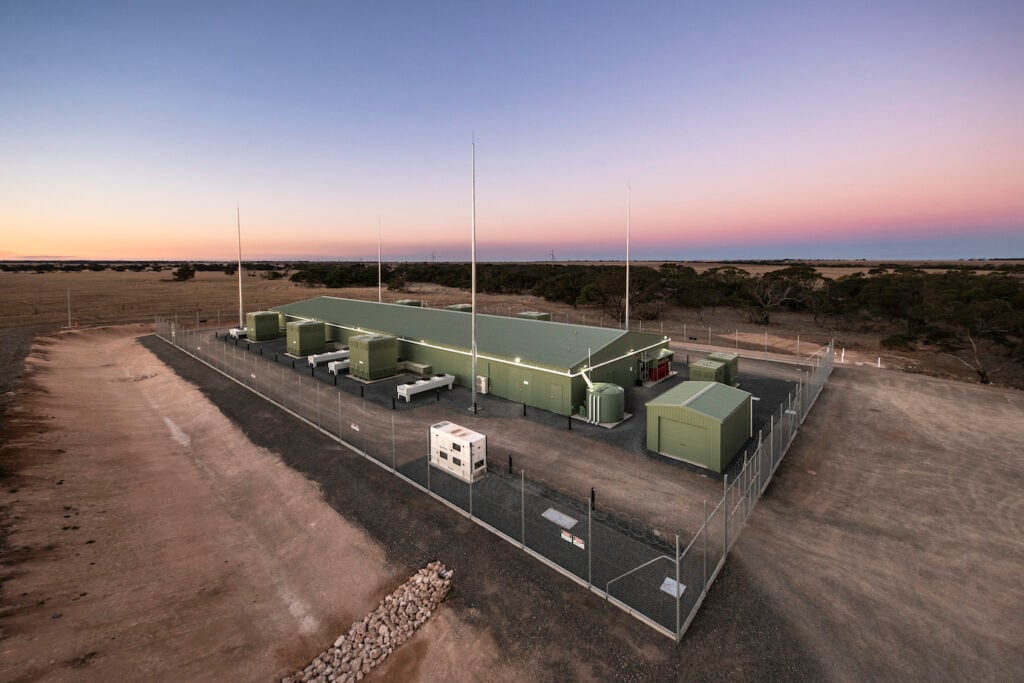
Hitachi Energy has won a tender to supply a large-scale battery energy storage system (BESS) in the Northern Territory, Australia.
The 35MW BESS will enable cost savings for operation of the Darwin-Katherine Electricity System network which serves about 150,000 customers. The contract award has been described this week as a “huge step forward in our plan for 50% renewables by 2030,” by Northern Territory (NT) Minister for Renewables and Energy, Eva Lawler.
Enjoy 12 months of exclusive analysis
- Regular insight and analysis of the industry’s biggest developments
- In-depth interviews with the industry’s leading figures
- Annual digital subscription to the PV Tech Power journal
- Discounts on Solar Media’s portfolio of events, in-person and virtual
Called the Darwin-Katherine Battery Energy Storage System (DK BESS), it will add flexibility and increase reliability of electricity supply, providing spinning reserve services currently delivered by natural gas power plants. It will also directly replace a generating unit which provides contingency generation during power system events.
State government-owned power producer Territory Generation launched the two-part procurement process in early November, comprising a prequalification round and a subsequent request for proposals.
At the launch of the tender, Territory Generation CEO Gerhard Laubscher said the process was a collaborative one involving planning with multiple stakeholders from both government and industry to ensure the project’s value to the NT was maximised.
While the DK BESS will cost around AU$45 million (US$32 million), it is expected to save the network around AU$9.8 million in operating costs every year, meaning it will have paid back in about five years.
In common with several large-scale BESS projects around Australia, one of the primary purposes of the system is to enable the smooth integration of solar energy into the electricity grid.
Around one in six NT households have rooftop solar, a lower proportion perhaps than other Australian states like Western Australia and South Australia, where some statistics put the proportion closer to one in two or one in three, but nonetheless, battery storage will enable more capacity for homes and businesses in the region to go solar.
The DK BESS will be built at the site of Territory Generation’s Channel Island Power Station. It will run continuously, using Hitachi Energy’s virtual synchronous machine tech to provide inertia to the system, smoothing out the variability of solar generation, a service that would otherwise be done using gas.
‘Renewables are the way forward’
Although Hitachi Energy launched as a brand in October this year, its predecessor brand Hitachi ABB Power Grids actually carried out work on Australia’s first battery-as-virtual synchronous machine project, at Dalrymple in South Australia a couple of years ago.
Hitachi Energy’s head of Grid Edge Solutions, Maxine Ghavi, told this site a while back that that project could provide learnings for the rest of the world on the role BESS can play in stabilising the grid.
“The awarding of the BESS tender is a huge step forward in our plan for 50% renewables by 2030 – it is the cornerstone of our Darwin-Katherine System Plan,” NT renewables and energy minister Eva Lawler said.
“We want Territorians to have access to the latest and best technology as we build a stronger and more resilient power system for Territory households and businesses. Our electricity will be reliable and stable, while also being affordable for Territorians.
“Renewables are the way forward, this is why we are investing in the BESS and hydrogen powered generators so we can have clean and efficient energy which helps us reach our renewables and net zero emission targets.”
The Darwin-Katherine Electricity System Plan referred to by Lawler targets net zero by 2050 and includes plans to encourage low-emissions manufacturing, zero-emissions data centres and renewable hydrogen development in the region, in addition to the 35MW DK BESS, support schemes for home and business battery storage and for solar at schools in the NT.
The project, to which Hitachi Energy will supply “major components,” is also a major part of Territory Generation’s plans to upgrade its generation and supply fleet and in common with several other large battery projects around Australia at former or existing thermal power plant sites is expected to take advantage of infrastructure already in place, like grid interconnection.
“Hitachi Energy’s battery energy storage solution will be part of an intelligent electrical ecosystem and ensure full utilisation of solar energy generation and less reliance on fossil fuels,” Bernard Norton, Hitachi Energy Australia’s country managing director said.
“This battery energy storage system will allow greater penetration of renewable energy in the Territory, helping to ensure a sustainable, flexible and secure energy system for today’s generations and those to come.”






